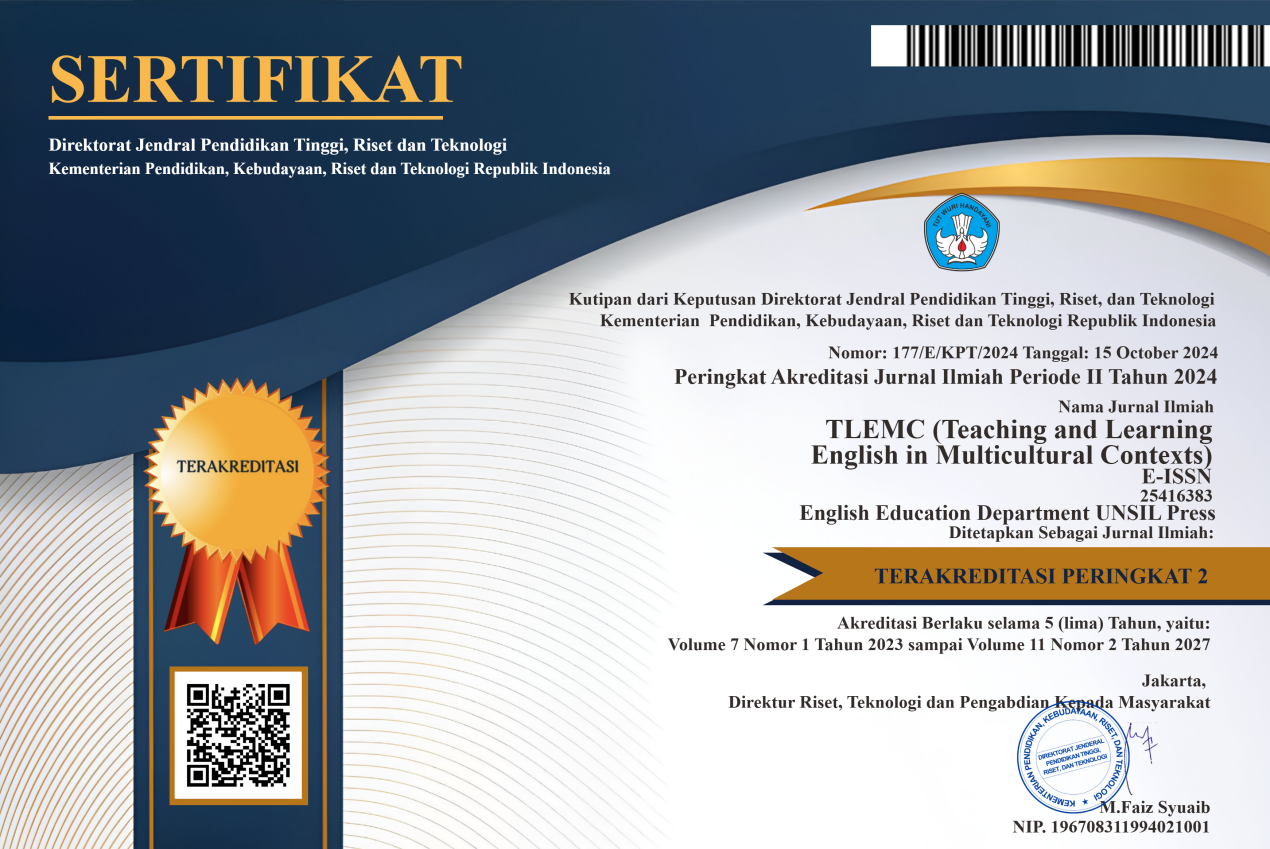READING ANXIETY IN ENGLISH AS A FOREIGN LANGUAGE FOR UNDERGRADUATE STUDENTS IN INDONESIA
Abstract
Full Text:
PDFReferences
Ahmad, I. S., Al-Shboul, M. M., Nordin, M. S., Rahman, Z. A., Burhan, M., & Madarsha, K. B. (2013). The Potential Sources of Foreign Language Reading Anxiety in a Jordanian EFL Context: A Theoretical Framework. English Language Teaching, 6 (11). doi:10.5539/elt.v6n11p89
Akkakoson, S. (2016). Speaking Anxiety in English Conversation Classrooms among Thai Students. Malaysian Journal of Learning and Instruction, 13 (1)1 June 2016), 63-82. doi:10.32890/mjli2016.13.1.4
Ary, D., Jacobs, L.C., & Sorensen, C. (2010). Introduction to Research in Education. Eighth Edition. United States of America: Wadworth.
Braun, V., & Clarke, V. (2006). Using thematic analysis in psychology. Qualitative research in psychology, 3(2), 77-101.
Gardner, R. C., Tremblay, P. F., & Masgoret, A. (1997). Towards a Full Model of Second Language Learning: An Empirical Investigation. The Modern Language Journal, 81(3), 344. doi:10.2307/329310
Horwitz, E. K., Horwitz, M. B., & Cope, J. (1986). Foreign Language Classroom Anxiety. The Modern Language Journal,70(2), 125. doi:10.2307/327317
Jalongo, M. R., & Hirsh, R. A. (2010). Understanding Reading Anxiety: New Insights from Neuroscience. Early Childhood Education Journal, 37(6), 431-435. doi:10.1007/s10643-010-0381-5
Khodadady, E., & Khajavy, G. H. (2013). Exploring the Role of Anxiety and Motivation in Foreign Language Achievement: a Structural Equation Modeling Approach. Porta Linguarum: Revista Internacional de Didáctica de Las Lenguas Extranjeras, (20), 269–286. Retrieved from http://dialnet.unirioja.es/servlet/articulo?codigo=4597527&info=resumen&idioma=ENG
Kuru-Gonen, I. (2007). L2 reading anxiety: Exploring the phenomenon. In JALT2006 Conference Proceedings (Vol. 2006, pp. 1029–1038). Tokyo, Japan: The Japan Association for Language Teaching.
Kuru-Gonen, I. (2009). The Sources of Foreign Language Reading Anxiety of Students in a Turkish EFL Context. EDUCATIONAL TECHNOLOGIES (EDUTE ’09), 50–55. https://doi.org/10.5220/0007099904460451
Liu, Y. (2011). Syntactic differences and foreign language reading anxiety: An investigation of Taiwanese university students (Unpublished doctoral dissertation).
Marwan, A. (2007). Investigating Students’ Foreign Language Anxiety. Malaysian Journal of ELT Research, 3, 37–55.
Saito, Y., Garza, T. J., & Horwitz, E. K. (1999). Foreign Language Reading Anxiety. The Modern Language Journal,83(2), 202-218. doi:10.1111/0026-7902.00016
Spielberger, C. D. (1966). Anxiety and Behavior. New York: Academic Press.
Spielberger, C. D., & Sarason, I.G. (2005). Stress and Emotion: Anxiety, Anger, and Curiosity. New York: Taylor and Francis Group, LLC.
Yin, R. K. (2018). Case Study Research and Application: Design and Methods. Sixth Edition. London: SAGE Publication, Inc.
Zhao, A. (2009). Foreign language reading anxiety: Investigating English-speaking university students learning Chinese as a foreign language in the United States (Unpublished doctoral dissertation).
DOI: https://doi.org/10.37058/tlemc.v3i2.1275
Refbacks
- There are currently no refbacks.
INDEXED BY:
This work is licensed under a Creative Commons Attribution-NonCommercial-ShareAlike 4.0 International License.
![]()
TLEMC (Teaching and Learning English in Multicultural Contexts)
Program Studi Pendidikan Bahasa Inggris
Fakultas Keguruan dan Ilmu Pendidikan
Universitas Siliwangi
Jl. Siliwangi No. 24 Kota Tasikmalaya - 46115
email: tlemc@unsil.ac.id





